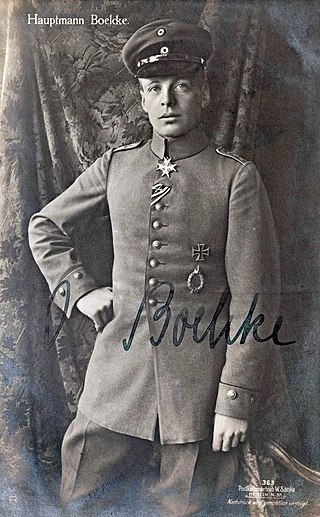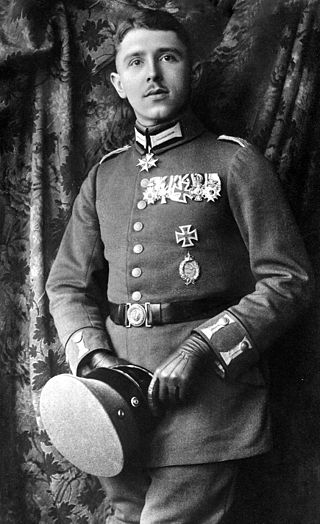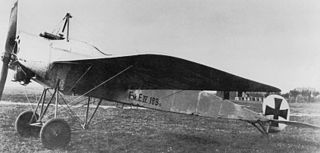
A monoplane is a fixed-wing aircraft configuration with a single mainplane, in contrast to a biplane or other types of multiplanes, which have multiple planes.

The Fokker Scourge occurred during the First World War from July 1915 to early 1916. Imperial German Flying Corps units, equipped with Fokker Eindecker fighters, gained an advantage over the Royal Flying Corps (RFC) and the French Aéronautique Militaire.

Oswald Boelcke PlM was a World War I German professional soldier and pioneering flying ace credited with 40 aerial victories. Boelcke is honored as the father of the German fighter air force, and of air combat as a whole. He was a highly influential mentor, patrol leader, and tactician in the first years of air combat, 1915 and 1916.

Max ImmelmannPLM was the first German World War I flying ace. He was a pioneer in fighter aviation and is often mistakenly credited with the first aerial victory using a synchronized gun, which was in fact achieved on 1 July 1915 by the German ace Kurt Wintgens. Immelmann was the first aviator to receive the Pour le Mérite, colloquially known as the "Blue Max" in his honour, being awarded it at the same time as Oswald Boelcke. His name has become attached to a common flying tactic, the Immelmann turn, and remains a byword in aviation. He is credited with 15 aerial victories.

This is a list of aviation-related events from 1915:

World War I was the first major conflict involving the large-scale use of aircraft. Tethered observation balloons had already been employed in several wars and would be used extensively for artillery spotting. Germany employed Zeppelins for reconnaissance over the North Sea and Baltic and also for strategic bombing raids over Britain and the Eastern Front.

The Fokker Eindecker fighters were a series of German World War I monoplane single-seat fighter aircraft designed by Dutch engineer Anthony Fokker. Developed in April 1915, the first Eindecker ("Monoplane") was the first purpose-built German fighter aircraft and the first aircraft to be fitted with a synchronization gear, enabling the pilot to fire a machine gun through the arc of the propeller without striking the blades. The Eindecker gave the German Army's Air Service (then the Fliegertruppen des deutschen Kaiserreiches) a degree of air superiority from July 1915 until early 1916. This period, during which Allied aviators regarded their poorly armed aircraft as "Fokker Fodder", became known as the "Fokker Scourge".

The Fokker E.II was the second variant of the German Fokker Eindecker single-seat monoplane fighter aircraft of World War I. The E.II was essentially a Fokker E.I with the 75 kW (100 hp) Oberursel U.I 9-cylinder rotary engine, a close copy of the French Gnôme Monosoupape rotary of the same power output, in place of the E.I's 60 kW (80 hp) Oberursel U.0, but whereas the E.I was simply a M.5K with a 7.92 mm (.312 in) machine gun bolted to it, the E.II was designed with the weapon system integrated with its airframe.

The Fokker E.III was the main variant of the Eindecker fighter aircraft of World War I. It entered service on the Western Front in December 1915 and was also supplied to Austria-Hungary and Turkey.

The Fokker E.IV was the final variant of the Eindecker fighter aircraft that was operated by Germany during World War I.

The Fokker M.5 was an unarmed single-seat monoplane aircraft designed and built by Anthony Fokker in 1913. It served as a light reconnaissance aircraft with the German army at the outbreak of World War I and was the basis for the first successful fighter aircraft in German service, the Fokker E.I.

The Morane-Saulnier L, or Morane-Saulnier Type L, or officially MoS-3, was a French parasol wing one or two-seat scout aeroplane of the First World War. The Type L became one of the first successful fighter aircraft when it was fitted with a single machine gun that fired through the arc of the propeller, which was protected by armoured deflector wedges. Its immediate effectiveness in this role launched an arms race in fighter development, and the Type L was swiftly rendered obsolete. The original Type L used wing warping for lateral control, but a later version designated Type LA was fitted with ailerons.

The Deutsche Luftstreitkräfte – known before October 1916 as Die Fliegertruppen des deutschen Kaiserreiches – was the air arm of the Imperial German Army. In English-language sources it is usually referred to as the Imperial German Air Service, although that is not a literal translation of either name. German naval aviators of the Marine-Fliegerabteilung were an integral part of the Imperial German Navy. Both military branches operated aeroplanes, observation balloons and airships.

The Fokker D.III was a German single-seat fighter aircraft of World War I. It saw limited frontline service before being withdrawn from combat in December 1916.

LeutnantOtto Parschau was a German World War I flying ace and recipient of the Pour le Mérite, Royal House Order of Hohenzollern, and Iron Cross, First Class. He was noted as one of the pre-eminent aces on the Fokker Eindecker. He was one of the world's first flying aces. Parschau and Leutnant Kurt Wintgens were the pilots chosen to fly the prototype of the revolutionary Fokker Eindecker fighter plane with a machine gun synchronized to fire safely through its propeller arc via use of a gun synchronizer.

LeutnantKurt Wintgens was a German World War I fighter ace. He was the first fighter pilot to score an aerial victory with a synchronized machine gun. Wintgens was the recipient of the Iron Cross and the Pour le Mérite.

The Morane-Saulnier H was an early aircraft first flown in France in the months immediately preceding the First World War; it was a single-seat derivative of the successful Morane-Saulnier G with a slightly reduced wingspan Like the Type G, it was a successful sporting and racing aircraft: examples serving with the French army were used in the opening phases of the war.
Royal Prussian Jagdstaffel 1 was a fighter squadron of the Luftstreitkräfte, the air arm of the Imperial German Army during World War I. Jasta 1 was founded on 22 August 1916, using single seat fighters drawn from First Army. It was one of the first wave of dedicated fighter squadrons founded as a result of Oswald Boelcke's espousal of massing fighter air power. Leopold Reimann scored the first of its 138 aerial victories two days later. It served on the Western Front until September 1917, transferred directly to the Italian Front to serve until March 1918, then returned to France for the rest of the war.

OberleutnantHans Berr was a German professional soldier and World War I flying ace. At the start of the First World War, he served in a scout regiment until severely wounded; he then transferred to aviation duty. Once trained as a pilot, he helped pioneer the world's first dedicated fighter airplane, the Fokker Eindecker "flying gun". Flying one, Berr shot down two enemy airplanes in March 1916 as his contribution to the Fokker Scourge. Berr was then chosen to command one of the world's original fighter squadrons, Jagdstaffel 5. Leading his pilots by example, Berr scored eight more victories in a four week span in October - November 1916 while his pilots began to compile their own victories. Hans Berr was awarded Germany's highest military honor, the Pour le Merite, on 4 December 1916. During a 6 April 1917 dogfight, Berr and his wingman mortally collided.

During World War I, the national air services involved developed their own methods of assessing and assigning credit for aerial victories.






















